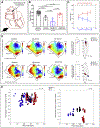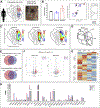Evidence of Superior and Inferior Sinoatrial Nodes in the Mammalian Heart
- PMID: 33357580
- PMCID: PMC7770336
- DOI: 10.1016/j.jacep.2020.09.012
Evidence of Superior and Inferior Sinoatrial Nodes in the Mammalian Heart
Abstract
Objectives: This study sought to investigate the shift of leading pacemaker locations in healthy and failing mammalian hearts over the entire range of physiological heart rates (HRs), and to molecularly characterize spatial regions of spontaneous activity.
Background: A normal heartbeat originates as an action potential in a group of pacemaker cells known as the sinoatrial node (SAN), located near the superior vena cava. HRs and the anatomical site of origin of pacemaker activity in the adult heart are known to dynamically change in response to various physiological inputs, yet the mechanism of this pacemaker shift is not well understood.
Methods: Optical mapping was applied to ex vivo rat and human isolated right atrial tissues, and HRs were modulated with acetylcholine and isoproterenol. RNA sequencing was performed on tissue areas that elicited spontaneous activity, and comparisons were made to neighboring myocardial tissues.
Results: Functional and molecular evidence identified and confirmed the presence of 2 competing right atrial pacemakers localized near the superior vena cava and the inferior vena cava-the superior SAN (sSAN) and inferior SAN (iSAN), respectively-which preferentially control the fast and slow HRs. Both of these regions were evident in non-failing rat and human hearts and maintained spontaneous activity in the rat heart when physically separated from one another. Molecular analysis of these 2 pacemaker regions revealed unique but similar transcriptional profiles, suggesting iSAN dominance when the sSAN is silent.
Conclusions: The presence of 2 spatially distinct dominant pacemakers, sSAN and iSAN, in the mammalian heart clarifies previous identification of migrating pacemakers and corresponding changes in P-wave morphology in mammalian species.
Keywords: arrhythmias; optical mapping; pacemaker; sinoatrial node.
Copyright © 2020 The Authors. Published by Elsevier Inc. All rights reserved.
Conflict of interest statement
Author Disclosures Drs. Brennan and Efimov were supported by National Institutes of Health Stimulating Peripheral Activity to Relieve Conditions (SPARC) grant 3OT2OD023848. Drs. Chen and Peng were supported by National Institutes of Health grants AI121080 and AI139874. All other authors have reported that they have no relationships relevant to the contents of this paper to disclose.
Figures







Comment in
-
The Sinus Node: Still Mysterious After All These Years.JACC Clin Electrophysiol. 2020 Dec;6(14):1841-1843. doi: 10.1016/j.jacep.2020.09.017. Epub 2020 Nov 25. JACC Clin Electrophysiol. 2020. PMID: 33357581 Free PMC article. No abstract available.
References
-
- Schuessler RB, Boineau JP, Bromberg BI. Origin of the sinus impulse. J Cardiovasc Electrophysiol 1996;7:263–74. - PubMed
-
- Boyett MR, Honjo H, Kodama I. The sinoatrial node, a heterogeneous pacemaker structure. Cardiovasc Res 2000;47:658–87. - PubMed
-
- Lu HH. Shifts in pacemaker dominance within the sinoatrial region of cat and rabbit hearts resulting from increase of extracellular potassium. Circ Res 1970;26:339–46. - PubMed
-
- Mackaay AJC, Op’t Hof T, Bleeker WK, Jongsma HJ, Bouman LN. Interaction of adrenaline and acetylcholine on cardiac pacemaker function. Functional inhomogeneity of the rabbit sinus node. J Pharmacol Exp Ther 1980;214:417–22. - PubMed
Publication types
MeSH terms
Grants and funding
LinkOut - more resources
Full Text Sources
Molecular Biology Databases

